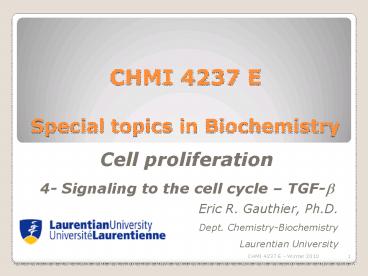CHMI 4237 E Special topics in Biochemistry - PowerPoint PPT Presentation
1 / 23
Title:
CHMI 4237 E Special topics in Biochemistry
Description:
CHMI 4237 E Special topics in Biochemistry Cell proliferation 4- Signaling to the cell cycle TGF-b Eric R. Gauthier, Ph.D. Dept. Chemistry-Biochemistry – PowerPoint PPT presentation
Number of Views:90
Avg rating:3.0/5.0
Title: CHMI 4237 E Special topics in Biochemistry
1
CHMI 4237 ESpecial topics in Biochemistry
Cell proliferation 4- Signaling to the cell cycle
TGF-b
- Eric R. Gauthier, Ph.D.
- Dept. Chemistry-Biochemistry
- Laurentian University
2
So, what are the BIG questions
- 1) How does the basic cell cycle machinery work?
- 2) How does the cell ensure that a given step in
the cell cycle is properly completed before
moving forward? - 3) What are the signals that modulate the cell
cycle?
3
Transforming growth factor beta
- Isolated as a component of sarcoma growth
factor - Triggers a number of biological effects,
including cell proliferation and cell cycle
arrest
4
Transforming growth factor beta
- Family of over 33 proteins, which includes
- TGFb
- Bone morphogenetic proteins (BMPs)
- Activins
- Growth and differentiation factors (GDFs)
- Number of effects
- Proliferation (stimulation/inhibtion)
- Differentiation
- Cell adhesion
- Cell migration
- Cell death
5
TGF-b secretion
- TGF-b is first synthesized on the ribosome as a
pre-pro-protein - The pre-sequence is removed during insertion into
the ER lumen - During its transit in the secretory pathway,
TGF-b is processed and converted into its
secreted form, associated with LTBP - Active TGF is release by the action of a number
of factors, including - Metalloproteases MMP-2 / MMP9
- Plasmin
- Integrins (i.e. extracellular matrix)
6
TGF-b receptor
- TGF-b triggers its effects on the cell by causing
the dimerization of two subunits of the TGF
receptor - Single-span membrane proteins
- Possess Ser/Thr kinase activity
- TbR-I subunit
- possess a 30-amino acid GS domain preceding the
kinase domain - TbR-II subunit
- Activates receptor in a ligand-specific manner by
phosphorylating the GS sequence of TbR-I - Doesnt have a GS sequence
7
TbR-I activation
- In the absence of ligand TbR-I is inhibited by
its GS sequence, which is wedged in the N lobe of
the Ser/Thr kinase domain - This prevents ATP binding by the N-lobe
- TbR-I is stabilized in this form through the
binding of FKBP12
8
TbR-I activation
- TGF binding causes the dimerization of TbR-I and
TbR-II - TbR-II phosphorylates the GS sequence
- This is sufficient to dislodge the GS sequence
from the N- lobe and allow ATP binding
Signal Transduction. 2nd edition. 2009. Academic
Press
9
TbR-I activation
- Phosphorylated TbR-I acts as a docking site for
the actual signal transducers a family of
proteins called R-SMADS - SMADS are brought to the TbR-I/TbR-II dimer by a
membrane-bound protein called SARA - R-SMAD phosphorylation by TbR-I triggers the
signaling cascade.
10
SMADS
- Three classes are recognized
- R-SMAD initiate signaling at the TbR
- SMAD4 modulates the expression of target genes
- Inhibitory SMADs involved in signal termination
- Main protein regions
- 1) MH1
- Binds DNA at the SMAD binding element (SBE) in
the promoter of target genes - Binds a number of transcription factors
- 2) linker region
- hot spot for phosphorylation
- PPxY motif binding site for E3 ubiquitin ligase
- Nuclear export signal (SMAD4 only).
- 3) MH2
- hydrophobic corridor (patch of hydrophobic amino
acids) mediating protein interactions with SARA
(cytoplasmic retention), nuclear pore proteins
and transcription factors - SxS motif phosphorylated by TbR-I
11
SMADS
12
SMADS
- When phosphorylated by TbR-I, the SxS motif
interacts with a basic pocket in MH2 - This promotes heteromerization between selective
effector SMADs
13
R-SMADS
- R-SMADS are specific to particular TGF family
receptors - TbR-I (L45 loop) binds the L3 loop of the MH2
domain of R-SMADS - This ensures specificity of interaction
- The phosphorylated GS sequence also binds the
basic pocket of the R-SMAD (this is the on-off
signal) - Upon R-SMAD phosphorylation, the SxS sequence
binds the basic pocket, weakening the interaction
of R-SMADs with their cytoplasmic anchors and
favoring oligomerization of 2 R-SMADs with SMAD
4
14
R-SMADS/SMAD 4
15
Nuclear export and import
16
SMAD 4 and nuclear export
- SMAD4 doesnt have a SxS sequence and thus is not
phosphorylated by TbR-I - It also has a nuclear export sequence, which
keeps it in the cytosol - CRM1 binds the NES and mediates interaction with
nucleoporins - Heteromerization with R-SMADs masks the NES,
allowing SMAD4 to accumulate in the nucleus.
17
SMAD 4 and nuclear export
18
Gene modulation by SMADs
- R-SMAD/SMA4 4 blunts the expression of c-myc
through binding a TGFb inhibitory element
(TIB) in the c-myc promoter - This releases the inhibition on p21CIP
expression - R-SMAD/SMAD 4 also interacts with several
transcription factors to promote CKI gene
transcirption, leading to cell cycle inhition.
19
Gene modulation by SMADs
20
Modulation of SMAD Activity
- Dephosphorylation of SMADs in the nucleus leads
to their export to the cytosol - Phosphorylation of the linker region of SMADs
promote their regulation - Phosphorylation by CDKs and MAPKs lead to
cytosolic retention and degradation of SMADs
21
SMURFs
- C2 domains ? phospholipid-binding
- WW domains? mediate protein-protein interaction
- HECT domain E3 ubiquitin ligase activity
22
SMURFs
23
Modulation by inhibitory SMADs
- In the absence of TGFb, both are retained in the
nucleus - SMAD6 and SMAD7 are up-regulated and exported
into the cytosol following TGFb signalling - SMAD 6 competes with SMAD4 for R-SMAD1 binding
- SMAD7 binds with SMURF2 and mediates the
degradation of TbR-I

